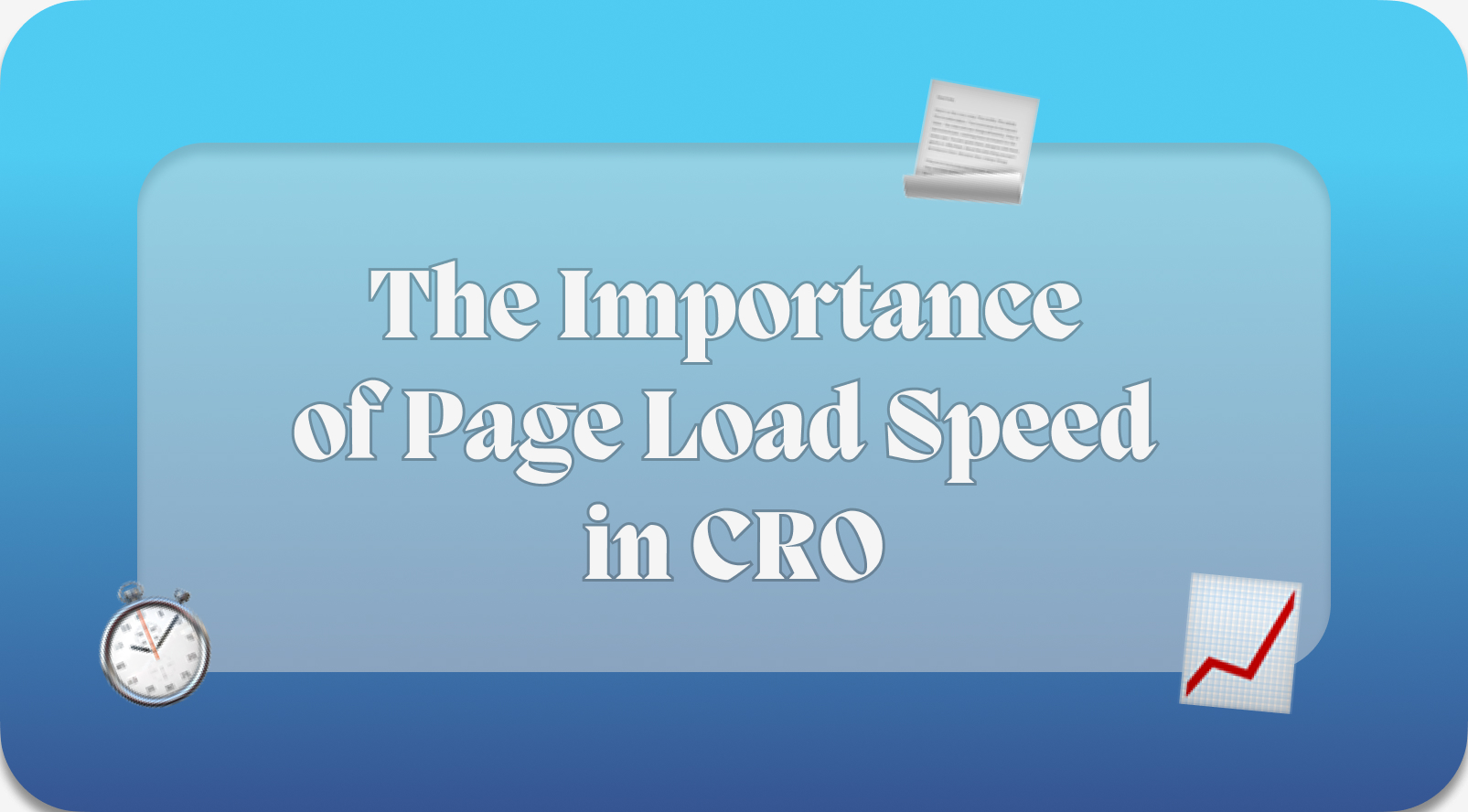The Importance of Page Load Speed in CRO: Boosting Conversion Rates Efficiently

The Importance of Page Load Speed in CRO: Boosting Conversion Rates Efficiently
In the realm of digital marketing and e-commerce, the speed at which a page loads is not merely a convenience—it's a critical factor influencing conversion rate optimization (CRO). Page load speed can significantly impact visitor behavior; users expect quick, responsive websites. A delay of even a few seconds can lead to increased bounce rates and lost revenue. Hence, optimizing page load speed is essential for maintaining an edge in an increasingly competitive digital landscape, where every element of a user's experience weighs heavily on the likelihood of conversion.

Optimizing page load speeds encompasses various techniques and strategies, ranging from simple image compression to more intricate server-side improvements. Crucially, it also includes crafting a mobile-responsive design, considering the large volume of traffic that comes from mobile devices. Faster websites have been shown to perform better not only in user experience but also in search engine rankings, consequently driving more traffic. With analytics tools, marketers and website owners can measure the direct impact of site speed on CRO and continuously refine their tactics to improve performance.
Key Takeaways
- Page load speed is key to converting visitors into customers.
- Mobile responsiveness and optimization techniques bolster CRO.
- Site speed enhancements can lead to better SEO rankings and data-driven CRO strategies.
Understanding Page Load Speed
Page load speed is a critical factor in shaping a user’s experience and a website’s overall performance. Fast-loading websites can lead to increased user satisfaction, while slow-loading ones can precipitate high bounce rates and lower conversions.
The Role of Page Load Time in User Experience
Faster page load time equates to a more satisfactory user experience. Users tend to prefer sites that load quickly, whereas sites that take too long can frustrate visitors and result in them leaving, or bouncing from the site. Studies have indicated that even a one-second delay can significantly disrupt the user experience.
Measuring Website Speed
Tools like Google PageSpeed Insights and GTmetrix offer detailed insights into a website's performance, pinpointing areas that need improvement. These tools measure Core Web Vitals, providing data on various aspects of speed such as the largest contentful paint, first input delay, and cumulative layout shift, which are essential for understanding how some users perceive a site.
Impact of Speed on Conversion Rates
Speed and conversion rates are directly correlated. For every second added to a page's load time, the potential for a 7% reduction in conversions increases. This alarming statistic highlights the need for speed optimization to keep visitor engagement high and to promote an optimal user experience. Google Analytics can help track how well pages are converting and how speed may be impacting those numbers, allowing website managers to make data-driven decisions to enhance website traffic and conversions.
Optimization Techniques for Enhanced Page Speed
Enhancing page speed is crucial for any website's success, especially in the realm of conversion rate optimization (CRO). Specific techniques can significantly reduce load times, providing a seamless user experience that can lead to better engagement and conversions.
Optimizing Images and Media
High-resolution images can drastically slow down a webpage. Image optimization can be achieved through scaling down images, utilizing compression, and choosing the right file format, such as JPEG for photographs and PNG for graphics with transparency. Employing lazy loading ensures that only images in the viewport load initially, which can immensely speed up the time to interactive.
Effective Use of CDNs
A Content Delivery Network (CDN) is a widespread network of servers that deliver cached content from a site to users based on their geographic location. Leveraging a CDN can greatly reduce latency by serving the site's static content like CSS files, JavaScript, and images from a server closest to the user, leading to faster page load times.
Minimizing HTTP Requests
A webpage's load time often increases due to the sheer number of HTTP requests it generates for various resources. To optimize, one should combine files wherever possible, such as merging multiple CSS or JavaScript files into single files. Additionally, browser caching stores resources locally on a user's computer, allowing them to load more quickly on subsequent visits.
Code Optimization Practices
Ensuring that code is lean and efficient is another vital aspect of page speed optimization. This includes practices like minifying HTML, CSS, and JavaScript, which reduces file size by removing unnecessary characters. Compression techniques like GZIP can also be utilized to shrink the size of resource files before they are sent over the network. It's essential to review and streamline any code that blocks rendering to minimize delays.
Implementing these optimization techniques will make webpages load faster, which is a stepping stone to achieving a better user experience and improving CRO efforts.
Mobile Optimization and Responsive Design
The intersection of mobile optimization and responsive design is critical in enhancing site speed and usability, which in turn favorably influences conversion rates for ecommerce platforms.
Accelerated Mobile Pages (AMP)
Accelerated Mobile Pages (AMP) are a compelling option for mobile optimization, designed to reduce the time content takes to load on mobile devices. AMP utilizes a simplified HTML, allowing pages to load with remarkable speed. The implementation of AMP effectively leads to enhanced user engagement and potentially higher conversion rates due to the swift, streamlined experience it provides.
Responsive Web Design Best Practices
Responsive Web Design (RWD) is a method that ensures web content is optimally displayed on various device sizes, improving usability and maintaining site speed. Key best practices include fluid grid layouts, flexible images, and media queries. By employing these practices, businesses ensure their ecommerce sites are accessible and efficient, leading to a better user experience and supporting healthy conversion rates regardless of the device used.
SEO Implications of Site Speed
The relationship between site speed and SEO is unequivocal; a website's loading time can have a significant impact on its search engine rankings. Search engines prioritize user experience, and fast-loading websites are seen as providing a better user experience compared to slower ones.
- Ranking Factor: Site speed is a well-established ranking factor. This means that websites that load quickly are likely to rank higher in organic search results, helping to increase organic traffic.
- Bounce Rate: A slow-loading site may result in a high bounce rate, signaling search engines that users are not finding the content engaging or relevant, potentially decreasing visibility.
- Indexing Efficiency: Faster sites can be indexed more efficiently by search engine crawlers. This leads to more pages being indexed, potentially improving the site's SEO.
Search engines such as Google have made it clear that site speed influences a website's search performance. Conversion rates can also be tied to SEO; as site speed improves, this can lead to a better user experience, often causing an uptick in conversion rates. Moreover, a faster website can enhance user engagement and retention, factors that indirectly affect SEO outcomes.
In summary, optimizing a website's loading speed is not solely for the immediate benefit of user experience but is integral in solidifying an effective SEO strategy to outperform competition and secure top positions in search engine results, making site speed optimization crucial for sustained SEO success.
Leveraging Analytics for CRO
To effectively optimize conversion rates, businesses must utilize analytics to understand and refine their digital marketing strategies. Through precise data analysis, eCommerce platforms can enhance user experience, tailor A/B testing efforts, and thereby improve sales and return on ad spend (ROAS).
A/B Testing for Performance Optimization
A/B testing is a critical method used to identify enhancements in website functionality that can lead to increased conversion rates. By testing different versions of a page or element, businesses can determine which changes positively impact customer behavior and sales. Analytics provide data-driven insights that guide these experiments, ensuring that decisions are not based on guesses but on actual user interaction data.
Sales Funnel Analysis
The sales funnel offers a visual representation of the customer journey, from awareness to conversion. Analyzing each stage of the funnel with robust analytics tools can highlight areas where prospective customers drop off. Companies can then strategically tweak their funnels, perhaps by adding compelling testimonials at critical touchpoints, to foster trust and encourage progression to the next phase.
Understanding Customer Acquisition Costs
Knowing what it costs to acquire each customer is essential for assessing the effectiveness of digital marketing efforts and ensuring sustainable business growth. Analytics are indispensable in tracking these costs across different channels and campaigns. eCommerce entities must weigh these costs against lifetime value to fine-tune conversion rate optimization strategies, thus achieving a healthy ROAS and sustaining profitability.
Real-World Outcomes of Page Load Speed on CRO
In the digital marketplace, conversion rate optimization (CRO) is crucial for e-commerce sites seeking to enhance user satisfaction and achieve higher conversion rates. The speed at which a website loads is a pivotal factor in website performance, directly influencing revenue and overall business results.
Customer experience often starts with how rapidly a page responds to a click. A delay of even a few seconds can dissuade potential customers, increasing bounce rates. The relationship between load times and page abandonment is stark, as faster websites tend to secure user loyalty and, thus, a superior return on investment (ROI).
- Walmart's Case Study: An improvement in page load time by one second was shown to lead to a 2% increase in conversions.
- Statistical Evidence: There's a reported 32% increase in the likelihood of a user leaving a site (bounce rate) when page load time goes from one to three seconds.
Here are some statistics demonstrating the impact of quick loading times on e-commerce success:
Page Load Time (Seconds)Probability of Bounce Increase1 to 332%1 to 10123%
Thus, ensuring fast load times is instrumental in not just retaining visitors but also in converting them into customers. Businesses that prioritize and improve their site's load speed are likely to see direct benefits in their conversion metrics, reflecting a better customer experience and a heightened potential for revenue growth.
Frequently Asked Questions
When it comes to conversion rate optimization (CRO), understanding the role of page load speeds is crucial. These FAQs tackle the core topics to help elucidate this aspect.
What are the effects of page load times on user experience?
Page load times have a direct impact on user experience, with slow-loading websites typically resulting in higher bounce rates and lower user engagement. Fast-loading sites contribute to a smoother user journey, enhancing overall satisfaction.
How does site speed affect a website's conversion rates?
Website conversion rates are significantly affected by page load speeds as faster sites tend to retain users longer, which increases the likelihood of converting visitors into customers. A quick-loading site simplifies the path to conversion, reducing the chance users will abandon the process.
Why should businesses prioritize optimizing page load speeds?
Businesses should prioritize optimizing page load speeds to improve user experience, which can lead to increased retention and higher conversion rates. Efficient load times are also a factor in search engine rankings, aiding in greater online visibility.
Stay up to date with our blog
Dive into our informative and engaging blog posts to stay informed on the latest trends in the Webflow & Shopify world as well on actionable tips to make your website work for you.



Contact us
We're only 1 email, call, message or meeting away. We'd be happy to help with your query. Book in a time on our calendar so we can speak.





